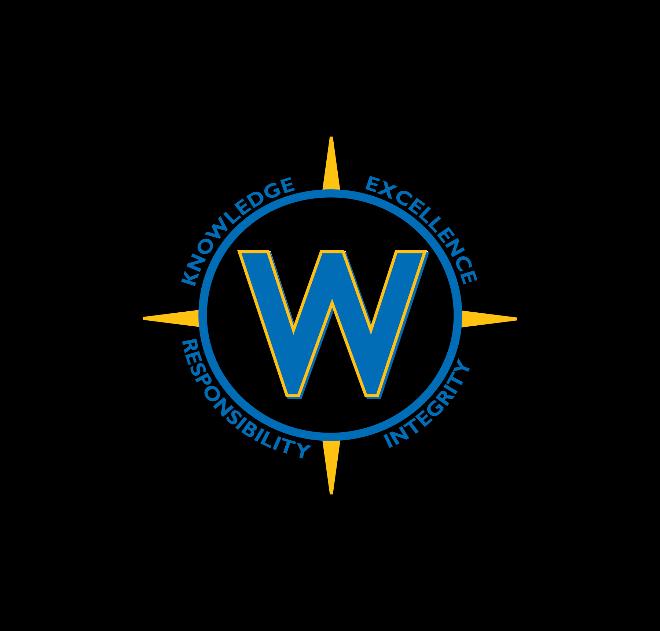
Waterford Public Schools
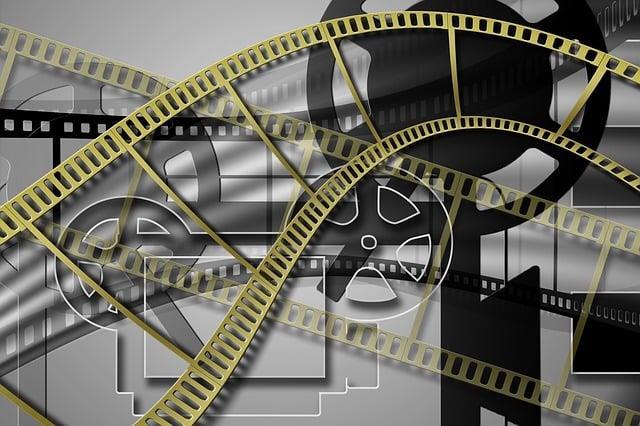
Grades 9-12
Theatre Courses 2024



Grades 9-12
Theatre Courses 2024
The following staff made significant contributions to the development of the Waterford Public Schools High School Theatre Course:
Patrick Barry Clark Lane Middle School & Waterford High School Drama Coach
Clark Lane Middle School Music/Chorus Teacher
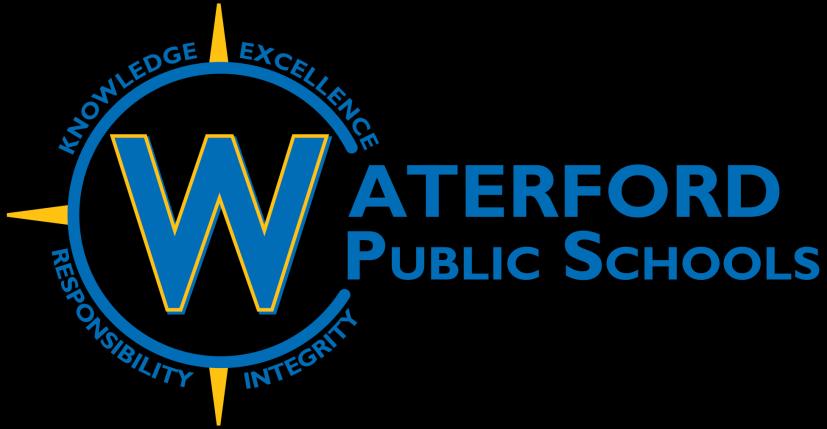


Our Vision of the Graduate aims to empower each student to be resilient, innovative, and develop a global perspective. Our Vision of the Graduate nurtures a community of lifelong learners equipped with critical thinking skills, compassion, and a drive for excellence, positioning them to flourish in a constantly evolving world.





1A: Listen actively to understand information.
1B: Use an appropriate method of communication.
1C: Create a logical and evidence-based argument.
1D: Deliver a clear and effective presentation or performance.
2A: Use appropriate research tools to acquire information from a variety of sources.
2B: Evaluate different perspectives, biases, and levels of credibility.
2C: Analyze information gathered from research tools to demonstrate understanding.
3A: Make reasonable predictions of a real-world issue.
3B: Analyze data in order to justify a claim.
4A: Persevere through challenging situations with flexibility and resourcefulness.
4B: Recognize how thoughts, feelings, and actions affect achievement.
4C: Work independently towards achieving a meaningful goal.
5A: Demonstrate respect for all cultures, identities, and perspectives.
5B: Practice responsible digital citizenship.

The shared experience of human-driven storytelling creates vital opportunities for the development of empathy and compassion. At the center of all these experiences is the core binding agent that defines humanity: hope. Sharing a unique experience of the imagination encourages us to construct community with those around us. Through a creative process centered on resourceful, collaborative problem-solving, theatre artists explore the use of ideas, performance techniques, and technical aspects to elicit an intended response.
Through engagement in one or more of these courses, students become increasingly independent in developing the following skills and habits.
WPS Vision of the Graduate: EFFECTIVE COMMUNICATORS:
● Develop an idea and explain the inspiration behind the concept
● Rehearse and deliver a performance for an audience based on individual role(s) in a production
● Actively listen to and interact with others’ ideas, points of view, and feedback to accomplish a goal or task
WPS Vision of the Graduate: INFORMATION ANALYSTS, CRITICAL THINKERS:
● Locate and analyze historical and cultural information for a given time period to support artistic choices
WPS Vision of the Graduate: SELF-DIRECTED LEARNERS, RESPONSIBLE CITIZENS
● Practice and hone technical skills that are essential to their role(s) in the production
● Design and execute with an ensemble or crew to produce a coherent experience for the audience
● Persevere through challenging situations with flexibility and resourcefulness
Instructional Approach
Theatre Arts students learn most effectively by doing. In every course, instruction centers on cocreating productions with students to build meaningful and substantive growth. The roles students play can be one or more of the following:
● Students as Authors: Writing scenes and short plays informed by their own diverse lived experiences, drawing on social and cultural issues that are meaningful to them.
● Students as Actors: Selecting, rehearsing, and performing characters both similar to and different from themselves, exploring their sense of their own developing identities through these performances.
● Students as Designers: Interpreting scenes as well as full scripts for the purpose of bringing to life their unique perspective on a story, delving into their understanding of themselves and their world through this process
● Students as Directors: Conceiving a point of view on a script and guiding a team through the rehearsal process to communicate that point of view to an audience.
● Students as Collaborators: Working independently and collaboratively toward a goal, integrating effective communication and regular self-reflection into their work.
● Students as Technicians: Researching, planning, problem solving, and executing the needs of a production from the technical side, through task-based work on a budget and deadline.
UNIT 1: 2-3 weeks
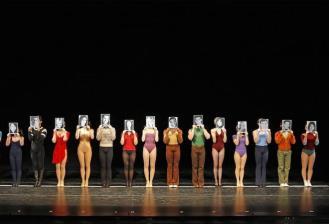
The dynamic art form of musical theatre calls on performers to sing, dance, and act. We jump right in with a boot camp to challenge and inspire through a series of empowering activities in each of these areas. We then showcase our strengths with a monologue/scene, a song, and a dance combination. We also develop strategies for unrehearsed (“cold”) readings of scenes.
LEARNING TARGETS
• I can analyze the text of a musical to discover layers of meaning that support my performance.
• I can make appropriate choices to portray a consistent, convincing character in a “cold” reading of a scene.
• I can confidently sing an audition song that showcases my personality and skills.
• I can perform a basic dance combination with stage presence and commitment.
We explore the history and performance of musical theatre through a thematic lens and present discoveries in the style of a cabaret performance. We develop skills in singing, dancing, and acting through rehearsal of musical theatre scenes and songs related to the ensemble’s chosen theme(s).
UNIT 2: 5-6 weeks
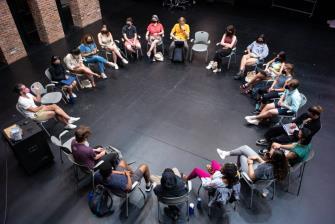
We explore Broadway and Off-Broadway musicals throughout history and consider influences and trends. Then we collaboratively develop a concept for our cabaret by examining what intrigues us, what stories we want to tell, and why we feel musical theatre empowers our ability to connect with others. We curate a collection of songs that demonstrates our theme
LEARNING TARGETS
• I can use historical and cultural references to develop a cohesive concept for a cabaret.
• I can curate a collection of musical excerpts based on a theme that intrigues me.
• I can manage resources equitably to create a shared experience that has value for all ensemble members.
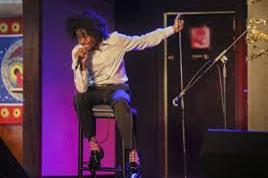
We cast our cabaret to showcase our individual and collective performing strengths. We collaborate with stage management throughout the rehearsal process and with technical crews during production to present a dynamic performance for an audience. Our presentation also includes short speeches to contextualize the songs and illustrate how they relate to our concept.
• I can collaborate with a director, music director, and choreographer to prepare a cabaret performance.
• I can make thoughtful physical, vocal, and physiological choices to develop a coherent and compelling performance.
• I can practice and develop various strategies for solving the actor’s challenge of characterization.
UNIT 3: 8-10 weeks 4
• I can listen to feedback from other stakeholders and incorporate constructive suggestions to develop my skills.
UNIT 1: 2-3 weeks
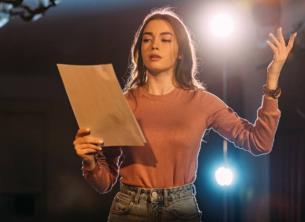
Theatre design and production involves the craft of visual storytelling for the stage: applying visual arts skills in a performing arts medium. We see scenery as sculpture, costumes as textiles fused with character, lighting as painting, and sound as music composition. We open this course by exploring each of these design strands and how it impacts the audience’s experience of the story.
LEARNING TARGETS
• I can explain the various jobs on a production and their related responsibilities, both independent and collaborative.
• I can analyze a script to determine the technical requirements for production.
• I can create a scenographic model based on a theme or concept.
• I can perceive how lighting and sound can evoke a mood.
We explore the history and performance of theatre through the design and production of technical elements such as set, costumes, lighting, and sound. We collaborate regularly as a team to work successfully toward a goal given certain resources of time, space, and budget.
UNIT 2: 2-3 weeks
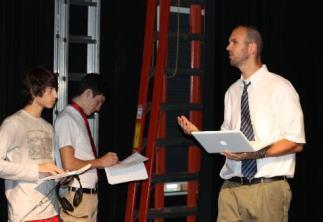
Choosing a design strand for a production of a given script, each crew—scenery, costumes, lighting, and sound makes constructive design choices to bring the action to life on stage. Following a design process of script analysis, research, experimentation, and reflection, we present our design boards and other materials for collaborative discussions with the director and other staff.
• I can manage resources equitably to create a shared experience that has value for all ensemble members.
• I can make constructive design choices to support the characters, themes, and socio-cultural landscape in a theatrical work.
• I can create a prop and/or costume plot that demonstrates an understanding of character and time period.
• I can create models, renderings, and elevations (physical as well as software-based, where appropriate) to communicate design concepts.
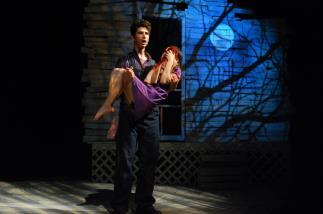
In the production phase, we work with the actors to ensure a captivating, committed performance that honors the work of the authors. With designs to guide us, we gather and construct what is needed. We also now collaborate in cross-disciplinary crews, adapting as appropriate to meet the timeline, budget, and vision. A post-performance talkback with the audience leads to further conversation and engagement.
• I can respectfully collaborate with a director and other staff to prepare the technical elements of a cabaret, musical, or play.
• I can manage resources equitably to create a shared experience that has value for all ensemble members.
• I can rehearse independently and with others to develop a coherent and compelling performance.
• I can listen to feedback and incorporate constructive suggestions to develop my skills.
UNIT 3: 11-13 weeks 5
• I can engage with diverse social and cultural perspectives on a work of theatre through a moderated audience talkback.
UNIT 1: 3-4 weeks

All plays are personal. They come from lived experience, mixed with observations and research into revealing portraits of human behavior. We begin by exploring how stories told on stage follow certain conventions and how learning those conventions frees us to reach beyond them in imaginative ways that serve our individual stories.
LEARNING TARGETS
• I can create a scene that uses motivation and conflict to communicate character and theme.
• I can develop strategies for creating effective scenes by studying the work and cultural influences of successful playwrights.
• I can analyze the text of a play to discover layers of meaning that support my performance.
• I can make appropriate choices to portray a consistent, convincing character that supports the playwright’s vision.
We explore the creation and performance of theatre through the writing, rehearsal, and production of a collection of student-written, student-directed, and student-designed oneact plays. We develop fundamental acting and stage management skills through the exploration of each play’s text.
UNIT 2: 5-6 weeks

With a firm grasp on how we reveal character through drama, we journey into a deep dive of one particular story that moves us. Employing a variety of strategies for structuring both scenes and one-acts, we develop our plays through informal readings and critiques, building a supportive playwrights circle to empower deeper exploration.
LEARNING TARGETS
• I can draft a script that captures an idea I find intriguing.
• I can use historical and cultural references to craft a believable world for my play where appropriate.
• I can seek and use feedback from a range of theatre stakeholders to develop the script.
• I can make constructive acting choices to support the characters, themes, and socio-cultural landscape in a theatrical work.
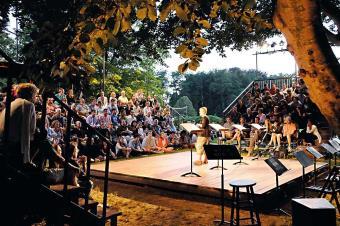
We learn further skills of characterization through the study of basic acting principles. We then explore the process of casting and producing a staged reading, the ways playwrights use critique to improve their work, and the production of a revised script for an audience. A post•performance talkback with the audience leads to further conversation and engagement.
• I can collaborate with a playwright/director to cast and prepare a staged reading and workshop production.
• I can make thoughtful physical, vocal, and physiological choices to develop a coherent and compelling performance.
• I can listen to feedback and incorporate constructive suggestions to develop my skills.
• I can engage with diverse social and cultural perspectives on a work of theatre through a moderated audience talkback.
UNIT 1: 2 weeks

Using a play’s text as a springboard, we work to convey truthful, consistent characters who communicate their inner and outer lives in complex ways. Through monologue study, we develop stage presence, conviction, and verbal fluency in a way that also showcases their abilities for a casting director. We also develop strategies for effectively showcasing our strengths in auditions.
LEARNING TARGETS
• I can analyze the text of a play to discover layers of meaning that support my performance.
• I can make appropriate choices to portray a consistent, convincing character in a familiar monologue that resonates with me.
• I can make appropriate choices to portray a consistent, convincing character in an unfamiliar monologue as part of an audition.
We explore the history and performance of theatre through the rehearsal and production of a full-length play. We develop advanced acting and stage management skills through the exploration of the play’s text, audition monologues, and related scenes.
UNIT 2: 11-13 weeks

With a full-length play in hand, we begin the process of discovery: careful examination of beats, thought patterns, figurative language, and actions. We also learn the role of the stage manager and the importance of managing resources of time and energy to run effective rehearsals. Regular self-reflection and critique help us continue to grow as storytellers and collaborators.
LEARNING TARGETS
• I can manage resources equitably to create a shared experience that has value for all ensemble members.
• I can make constructive acting choices to support the characters and themes in the work.
• I can collaborate with a director to prepare a theatrical production.
• I can rehearse independently and with others to develop a coherent and compelling performance.
• I can listen to feedback from other stakeholders and incorporate constructive suggestions to develop my skills.
UNIT 3: 3 weeks

Moving into the production phase, we collaborate with the designers and technicians to use visual storytelling techniques to expand our work. Costumes, make up, props, scenery, lighting, and sound all serve the story. We engage our audience in a truthful, committed performance that produces a unique, shared experience. A post-performance talkback with the audience leads to further conversation and engagement.
• I can collaborate with design crews to make supportive choices that tell the story effectively.
• I can perform, with conviction and commitment, a rehearsed play to provide an audience with a shared experience of a story.
• I can manage effectively the challenges and pressures of production week, balancing my personal health with my responsibility to the production.
• I can engage with diverse social and cultural perspectives on a work of theatre through a moderated audience talkback.
HSProficient
a.Investigatehowculturalperspectives, communityideasandpersonalbeliefsimpacta drama/theatrework.
HSProficient
a.Explorehowcultural,global,andhistoricbelief systemsaffectcreativechoicesinadrama/theatre work.
HSProficient
a.Researchhowothertheatreartistsapply creativeprocessestotellstoriesinadevisedor scripteddrama/theatrework,usingtheatre researchmethods.
b.Usebasictheatreresearchmethodstobetter understandthesocialandculturalbackgroundof adrama/theatrework.
HSAccomplished
a.Chooseandinterpretadrama/theatreworkto reflectorquestionpersonalbeliefs.
HSAccomplished
a.Integrateconventionsandknowledgefrom differentartformsandotherdisciplinestodevelop across-culturaldrama/theatrework.
HSAccomplished
a.Formulatecreativechoicesforadevisedor scripteddrama/theatreworkbasedontheatre researchabouttheselectedtopic.
b.Explorehowpersonalbeliefsandbiasescan affecttheinterpretationofresearchdataappliedin drama/theatrework.
HSAdvanced
a.Collaborateonadrama/theatreworkthat examinesacriticalglobalissueusingmultiple personal,community,andculturalperspectives.
HSAdvanced
a.Developadrama/theatreworkthatidentifies andquestionscultural,global,andhistoricbelief systems.
HSAdvanced
a.Justifythecreativechoicesmadeinadevised orscripteddrama/theatrework,basedonacritical interpretationofspecificdatafromtheatre research.
b.Presentandsupportanopinionaboutthe social,cultural,andhistoricalunderstandingsofa drama/theatrework,basedoncriticalresearch.
a.Applybasicresearchtoconstructideasabout thevisualcompositionofadrama/theatrework.
b.Exploretheimpactoftechnologyondesign choicesinadrama/theatrework.
c.Usescriptanalysistogenerateideasabouta characterthatisbelievableandauthenticina drama/theatrework.
a.Investigatehistoricalandculturalconventions andtheirimpactonthevisualcompositionofa drama/theatrework.
b.Understandandapplytechnologytodesign solutionsforadrama/theatrework.
c.Usepersonalexperiencesandknowledgeto developacharacterthatisbelievableand authenticinadrama/theatrework.
a.Synthesizeknowledgefromavarietyof dramaticforms,theatricalconventions,and technologiestocreatethevisualcompositionofa drama/theatrework.
b.Createacompletedesignforadrama/theatre workthatincorporatesallelementsoftechnology.
c.Integrateculturalandhistoricalcontextswith personalexperiencestocreateacharacterthatis believableandauthentic,inadrama/theatrework.
a.Explorethefunctionofhistoryandcultureinthe developmentofadramaticconceptthrougha criticalanalysisoforiginalideasina drama/theatrework.
b.Investigatethecollaborativenatureoftheactor, director,playwright,anddesignersandexplore theirinterdependentrolesinadrama/theatre work.
a.Refineadramaticconcepttodemonstratea criticalunderstandingofhistoricalandcultural influencesoforiginalideasappliedtoa drama/theatrework.
b.Cooperateasacreativeteamtomake interpretivechoicesforadrama/theatrework.
a.Developandsynthesizeoriginalideasina drama/theatreworkutilizingcriticalanalysis, historicalandculturalcontext,research,and westernornon-westerntheatretraditions.
b.Collaborateasacreativeteamtodiscover artisticsolutionsandmakeinterpretivechoicesin adevisedorscripteddrama/theatrework.
a.Practiceandreviseadevisedorscripted drama/theatreworkusingtheatricalstaging conventions.
b.Explorephysical,vocalandphysiological choicestodevelopaperformancethatis believable,authentic,andrelevanttoa drama/theatrework.
c.Refinetechnicaldesignchoicestosupportthe storyandemotionalimpactofadevisedor scripteddrama/theatrework.
a.Usetherehearsalprocesstoanalyzethe dramaticconceptandtechnicaldesignelements ofadevisedorscripteddrama/theatrework.
b.Useresearchandscriptanalysistorevise physical,vocal,andphysiologicalchoices impactingthebelievabilityandrelevanceofa drama/theatrework.
c.Re-imagineandrevisetechnicaldesignchoices duringthecourseofarehearsalprocessto enhancethestoryandemotionalimpactofa devisedorscripteddrama/theatrework.
a.Refine,transform,andre-imagineadevisedor scripteddrama/theatreworkusingtherehearsal processtoinventorre-imaginestyle,genre,form, andconventions.
b.Synthesizeideasfromresearch,scriptanalysis, andcontexttocreateaperformancethatis believable,authentic,andrelevantina drama/theatrework.
c.Applyahighleveloftechnicalproficienciesto therehearsalprocesstosupportthestoryand emotionalimpactofadevisedorscripted drama/theatrework.
HSProficient
a.Examinehowcharacterrelationshipsassistin tellingthestoryofadrama/theatrework.
b.Shapecharacterchoicesusinggiven circumstancesinadrama/theatrework.
HSProficient
a.Practicevariousactingtechniquestoexpand skillsinarehearsalordrama/theatre performance.
b.Useresearchedtechnicalelementstoincrease theimpactofdesignforadrama/theatre production.
HSAccomplished
a.Discoverhowuniquechoicesshapebelievable andsustainabledrama/theatrework.
b.Identifyessentialtextinformation,research fromvarioussources,andthedirector’sconcept thatinfluencecharacterchoicesina drama/theatrework.
HSAccomplished
a.Refinearangeofactingskillstobuilda believableandsustainabledrama/theatre performance.
b.Applytechnicalelementsandresearchto createadesignthatcommunicatestheconceptof adrama/theatreproduction.
HSAdvanced
a.Applyreliableresearchofdirectors’stylesto formuniquechoicesforadirectorialconceptina drama/theatrework.
b.Applyavarietyofresearchedactingtechniques asanapproachtocharacterchoicesina drama/theatrework.
a.Useandjustifyacollectionofactingexercises fromreliableresourcestoprepareabelievable andsustainableperformance.
b.Explainandjustifytheselectionoftechnical elementsusedtobuildadesignthat communicatestheconceptofadrama/theatre production.
a.Performascripteddrama/theatreworkfora specificaudience.
a.Presentadrama/theatreworkusingcreative processesthatshapetheproductionforaspecific audience.
a.Presentadrama/theatreproductionfora specificaudiencethatemploysresearchand analysisgroundedinthecreativeperspectivesof theplaywright,director,designer,anddramaturg.
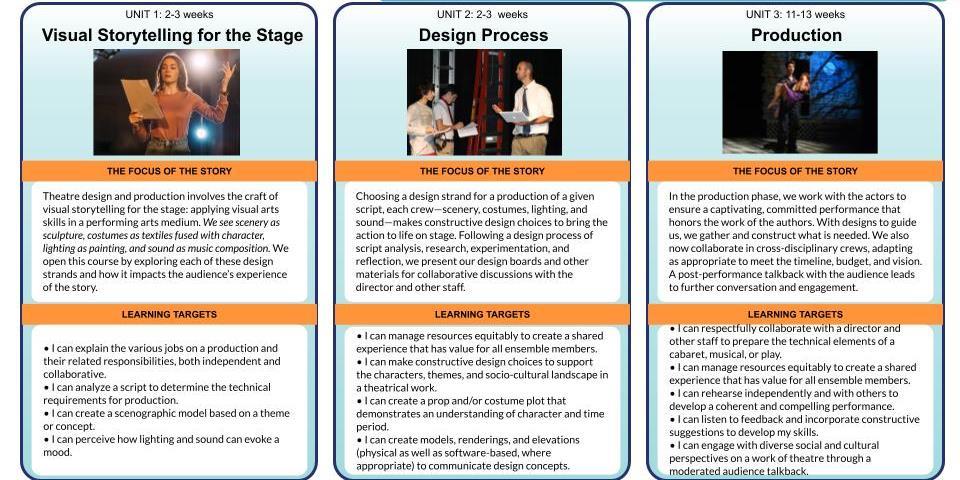
Students will explore the history and performance of theatre through the design and production of technical elements such as set, costumes, lighting, and sound. In this hands-on course, they will collaborate regularly as a team to work successfully toward a goal given certain resources of time, space, and budget. Opportunities may include guest artists and field trips to theatrical productions. This semester course may be taken more than once for credit.
Theater design and production involves the craft of visual storytelling for the stage: applying visual arts skills in a performing arts medium. We see scenery as sculpture, costumes as textiles fused with character, lighting as painting, and sound as music composition. We open this course by exploring each of these design strands and how it impacts the audience’s experience of the story.
From CT Arts Standards (Theatre)
● 1c. Use script analysis to generate ideas about a character that is believable and authentic in a drama/theatre work.
● 2b. Investigate the collaborative nature of the actor, director, playwright, and designers and explore their interdependent roles in a drama/theatre work.
● 3c. (I) Refine technical design choices to support the story and emotional impact of a devised or scripted drama/ theatre work.
● 5b. (I) Use researched technical elements to increase the impact of design for a drama/theatre production.
● Interpreting a script requires the development of personal voice and original ideas.
● Theater artists explore the use of ideas, performance techniques, and technical aspects to elicit an intended response.
● Develop an idea and explain the inspiration behind the concept
● Actively listen to and interact with others’ ideas, points of view, and feedback to accomplish a goal or task
● Locate and analyze historical and cultural information for a given time period to support artistic choices
● Practice and hone technical skills that are essential to their role(s) in the production
● How do the design strands weave together to impact the audience’s perception of the story?
● How do I apply other people’s ideas and/or techniques to build my craft?
● How do I develop an idea? What impact do I hope those choices will have on an audience?
● Four primary design strands: costume, lighting, scenery, sound
● Scale and how it works in a model
● I can analyze a script to determine the technical requirements for production.
● I can create a scenographic model based on a theme or concept.
● I can perceive how lighting and sound can evoke a mood.
Summative Assessment
● Create a scenographic model based on a theme or concept
● Identify and explain the design needs for a play
● Using a graphic organizer, create a plot of the scenic locations in a musical
● Watch videos of moments from different theatre works to explore how design choices impact mood
● Brainstorm ideas for a thematic concept that can be communicated in a set design
● I can analyze a script to determine the technical requirements for production.
● I can create a scenographic model based on a theme or concept.
● I can perceive how lighting and sound can evoke a mood.
● How do the design strands weave together to impact the audience’s perception of the story?
● How do I apply other people’s ideas and/or techniques to build my craft?
● How do I develop an idea? What impact do I hope those choices will have on an audience?
● Drafting sketches and then creating a scenographic (scale) model from foam, conservation board, and glue
● Experimenting with lighting fixtures and how the different elements of the fixture impact the beam
● Examining media clips of stage productions and reflecting, through journals as well as classroom conversation, on the mood evoked by the lighting and sound choices
● Researching the tasks involved in the design process for each strand; using the American Theatre Wing’s Working in the Theatre series of videos to learn from professionals about the different aspects of tech jobs in the theatre
● Analyzing a script for technical requirements as well as opportunities for the visual elements to contribute to the story
Course Name: Theatre Design and Production Unit Title: Design Process Est. # of Wks: 2-3
Unit Overview:
Choosing a design strand for a production of a given script, each crew scenery, costumes, lighting, and sound makes constructive design choices to bring the action to life on stage. Following a design process of script analysis, research, experimentation, and reflection, we present our design boards and other materials for collaborative discussions with the director and other staff.
From CT Arts Standards (Theatre)
● 4a. Examine how character relationships assist in telling the story of a drama/theatre work.
● 5b. (II) Apply technical elements and research to create a design that communicates the concept of a drama/theatre production.
● 10a. Investigate how cultural perspectives, community ideas and personal beliefs impact a drama/theatre work.
● 11.2b. Use basic theatre research methods to better understand the social and cultural background of a drama/theatre work.
● Theatre artists use appropriate terminology to effectively and efficiently communicate throughout the creative process.
● Theatre artists explore the use of ideas, performance techniques, and technical aspects to elicit an intended response.
● Theatre artists make thoughtful choices about their use of skills, techniques, and personal experience in hopes of creating a specific response for an audience.
● Develop an idea and explain the inspiration behind the concept
● Actively listen to and interact with others’ ideas, points of view, and feedback to accomplish a goal or task
● Locate and analyze historical and cultural information for a given time period to support artistic choices
● Design and execute with an ensemble or crew to produce a coherent experience for the audience
● What makes a performance piece memorable or powerful?
● How does the history of a performance piece influence my interpretation?
● What inspires creative ideas and how do I express them?
● How do we develop and communicate our crew’s design to connect with and support other crews' designs? Knowledge Skills (Framed as Learning Targets)
● Elements of a prop and/or costume plot
● Ground plans, front elevations, renderings, and other types of drawings
● Costume mock-ups, fabric swatches, materials suitable for choreography, use of synthetic materials
● Copyright rules regarding use of music in a play; royalties; licenses
● I can make constructive design choices to support the characters, themes, and sociocultural landscape in a theatrical work.
● I can create a prop and/or costume plot that demonstrates an understanding of character and time period.
● I can create models, renderings, and elevations (physical as well as softwarebased, where appropriate) to communicate design concepts.
Summative Assessment
● Work as a team to create, present, and modify a production design for one of the main design strands (set, costume, lighting, sound).
Formative Assessment
● Analyze the production’s technical needs and outline the budget for those items
● Use research to explore the social, cultural, and historical connections between the world of the play and its themes
● Prepare relevant slides, charts, and models for presenting the design to the other members of the team as well as the actors
● I can make constructive design choices to support the characters, themes, and sociocultural landscape in a theatrical work.
● I can create a prop and/or costume plot that demonstrates an understanding of character and time period.
● I can create models, renderings, and elevations (physical as well as softwarebased, where appropriate) to communicate design concepts.
● What makes a performance piece memorable or powerful?
● How does the history of a performance piece influence my interpretation?
● What inspires creative ideas and how do I express them?
● How do we develop and communicate our crew’s design to connect with and support other crews' designs?
● Researching the “world of the play” through various media including newspapers, magazines, visual art (painting, sculpture, textiles), fashion, and music; crafting a context for the characters’ motivations and conflicts
● Craft design boards, models, and renderings to assist the design process, particularly in conversations with the director and other design teams
● Using organizational software such as Google sheets to develop prop and costume plots that
others on the team can easily access and comment on as needed
● Script analysis exercises for implicit design elements beyond those directly stated in the stage directions
Course Name: Theatre Design and Production Unit Title: Production Est. # of Wks: 11-13
Unit Overview:
In the production phase, we work with the actors to ensure a captivating, committed performance that honors the work of the authors. With designs to guide us, we gather and construct what is needed. We also now collaborate in cross-disciplinary crews, adapting as appropriate to meet the timeline, budget, and vision. A post-performance talkback with the audience leads to further conversation and engagement.
Established Goals Transfer Goals
From CT Arts Standards (Theatre)
● 2b. Investigate the collaborative nature of the actor, director, playwright, and designers and explore their interdependent roles in a drama/theatre work.
● 3c. (II) Re-imagine and revise technical design choices during the course of a rehearsal process to enhance the story and emotional impact of a devised or scripted drama/theatre work.
● 6a. Perform a scripted drama/theatre work for a specific audience.
● 8c. Justify personal aesthetics, preferences, and beliefs through participation in and observation of a drama/theatre work.
● Theatre artists make thoughtful choices about their use of skills, techniques, and personal experience in hopes of creating a specific response for an audience.
● Theatre artists evaluate and refine their work through examination of relevant criteria, openness to new ideas, and persistence.
● Live theatre performance is an inherently unique human experience influenced in real time by the personalities and lived experiences of this particular set of
● Rehearse and deliver a performance for an audience based on individual role(s) in a production
● Practice and hone technical skills that are essential to their role(s) in the production
● Persevere through challenging situations with flexibility and resourcefulness
● What are we paying attention to as we rehearse and refine our play? How does the feedback we receive improve our performance?
● What am I learning about myself and my ability to handle challenging situations?
● How am I engaging with my audience during the performance and post-show talkback to make meaningful connections?
audience members, the physical and cultural climate at this performance, and the choices of actors and crew in response to these conditions.
● Purpose and nature of a post-show talkback
● Types of production rehearsals and their purposes in the creative process (such as paper tech, dry tech, wet tech, dress rehearsal)
● Types of rehearsal reports and how to complete them
● I can respectfully collaborate with a director and other staff to prepare the technical elements of a cabaret, musical, or play.
● I can manage resources equitably to create a shared experience that has value for all ensemble members.
● I can rehearse independently and with others to develop a coherent and compelling performance.
● I can listen to feedback from other stakeholders and incorporate constructive suggestions to develop my skills.
● I can engage with diverse social and cultural perspectives on a work of theatre through a moderated audience talkback.
Summative Assessment
● Perform a role in a play as part of a tech crew
● Engage in a question-and-answer session with audience members in a post-show talkback
Formative Assessment
● Participate in technical rehearsals such a cueto-cue and dress rehearsals to support the work of the actors
● Prepare nightly reports of concerns related to designated crew team
● Engage in post-rehearsal feedback sessions with the director for the improvement of the production and preparation for the talkback
● I can respectfully collaborate with a director and other staff to prepare the technical elements of a cabaret, musical, or play.
● I can manage resources equitably to create a shared experience that has value for all ensemble members.
● What are we paying attention to as we rehearse and refine our play? How does the feedback we receive improve our performance?
● What am I learning about myself and my ability to handle challenging situations?
● How am I engaging with my audience during
● I can rehearse independently and with others to develop a coherent and compelling performance.
● I can listen to feedback from other stakeholders and incorporate constructive suggestions to develop my skills.
● I can engage with diverse social and cultural perspectives on a work of theatre through a moderated audience talkback.
the performance and post-show talkback to make meaningful connections?
● Preparing for and conducting technical rehearsals: paper tech, dry tech, wet tech, and dress rehearsal
● Using schedules and priority lists to help manage the challenges of production week and achieve both individual and collective goals
● Collaborating with actors and stage management to ensure everyone is on the same page during the performance
● Actively and appropriately engaging in notes sessions, whether before or after rehearsal, in person or through written notes; reflecting constructively on how to improve the performance and move the production forward
● Journaling to reflect on what you’re learning about theatre and about yourself; using those reflections to set achievable goals with given resources
● Practicing audience talk-backs through informal interviews in both small and large group settings, with peers as well as with the director
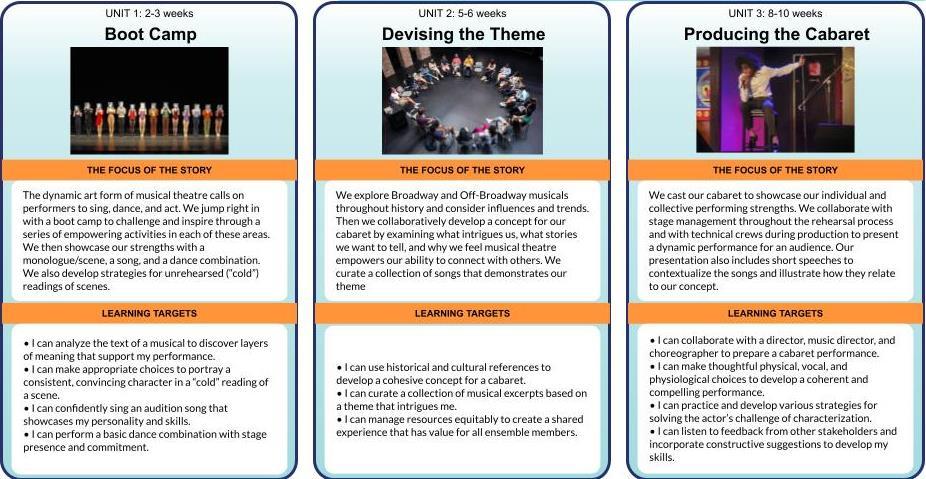
Students will explore the history and performance of musical theatre through a thematic lens and present their discoveries in the style of a cabaret performance. They will develop their skills in singing, dancing, and acting through the rehearsal of musical theatre scenes and songs related to the ensemble’s chosen theme(s). Material studied may include mature content. Opportunities may include guest artists and field trips to theatrical productions. This semester course may be taken more than once for credit.
Course Name: Musical Theatre Ensemble Unit Title: Boot Camp Est. # of Weeks: 2-3
Unit Overview:
The dynamic art form of musical theatre calls on performers to sing, dance, and act. We jump right in with a boot camp to challenge and inspire through a series of empowering activities in each of these areas. We then showcase our strengths with a monologue/scene, a song, and a dance combination. We also develop strategies for unrehearsed (“cold”) readings of scenes.
Established Goals
From CT Arts Standards (Theatre)
● 1c. Use script analysis to generate ideas about a character that is believable and authentic in a drama/theatre work.
● 4b. Shape character choices using given circumstances in a drama/theatre work.
● 5a. Practice various acting techniques to expand skills in a rehearsal or drama/theatre performance.
● MU:Pr6.1.E.Ib Demonstrate an understanding of expressive intent by connecting with an audience through prepared and improvised performances.
● DA:Pr5.1.5a. Recall and execute a series of dance phrases using fundamental dance skills (for example, alignment, coordination, balance, core support, kinesthetic awareness, clarity of movement).
Understandings
● Successful musical theatre auditions involve a combination of intense preparation and in the moment adaptability.
Knowledge
Transfer Goals
● Rehearse and deliver a performance for an audience based on individual role(s) in a production
● Actively listen to and interact with others’ ideas, points of view, and feedback to accomplish a goal or task
● Persevere through challenging situations with flexibility and resourcefulness
Essential Questions
● How do I prepare for an audition to make a good impression?
Skills (Framed as Learning Targets)
● Expectations of typical auditions
● Vocabulary such as 16-bar cut, 32-bar cut, up-tempo, ballad, “book,” combination, sides, “cattle call,” call back
● Audition etiquette, especially collaborating with an accompanist
● I can analyze the text of a musical to discover layers of meaning that support my performance.
● I can make appropriate choices to portray a consistent, convincing character in a “cold” reading of a scene.
● I can confidently sing an audition song that showcases my personality and skills.
● I can perform a basic dance combination with stage presence and commitment.
Summative Assessment Formative Assessment
● Perform a musical theatre audition consisting of singing, acting, and dancing components.
● Select and develop a short excerpt from a musical theatre song using appropriate resources (songbooks, teacher, online suggestions)
● Practice warm-up techniques for the voice and body
● Learn fundamental building blocks of choreography
● Practice cold readings of scenes
Learning Targets
● I can analyze the text of a musical to discover layers of meaning that support my performance.
● I can make appropriate choices to portray a consistent, convincing character in a “cold” reading of a scene.
● I can confidently sing an audition song that showcases my personality and skills.
● I can perform a basic dance combination with stage presence and commitment.
Essential Questions
● How do I prepare for an audition to make a good impression?
● Exploring musical theatre songs, both ballad and up-tempo, for good audition material; examining song structure as part of the process of selecting a 16- or 32-bar cut; evaluating whether the song provides the right opportunity for showcasing talent (using formal and informal rubrics)
● Warming up physically, mentally, and vocally to prepare for your best performance work, with and without access to space (room to stretch) and pitch support (like a piano)
● Practice cold readings and ways of implementing character details as you encounter them
● Exploring audition etiquette in interactions with the director as well as with auditionees
Course Name: Musical Theatre Ensemble Unit Title: Devising the Theme Est. # of Weeks: 5-6
Unit Overview:
We explore Broadway and Off-Broadway musicals throughout history and consider influences and trends. Then we collaboratively develop a concept for our cabaret by examining what intrigues us, what stories we want to tell, and why we feel musical theatre empowers our ability to connect with others. We curate a collection of songs that demonstrates our theme.
From CT Arts Standards (Theatre)
● 2a. Explore the function of history and culture in the development of a dramatic concept through a critical analysis of original ideas in a drama/theatre work.
● 10a. Investigate how cultural perspectives, community ideas and personal beliefs impact a drama/theatre work.
● 11.2b. Use basic theatre research methods to better understand the social and cultural background of a drama/theatre work.
● Music and movement are universal languages that move audiences as they explore cultural perspectives.
● Structure of a typical musical theatre work: overture or opening number, “I want” song, conflict, rising action, conclusion
● Unique features of musical theatre: multiple voices speak at the same time, use of dance to enhance meaning and mood
● Develop an idea and explain the inspiration behind the concept
● Actively listen to and interact with others’ ideas, points of view, and feedback to accomplish a goal or task
● Locate and analyze historical and cultural information for a given time period to support artistic choices
● What questions or themes do musicals explore that make the most of the medium?
● How do we develop a concept for a cabaret? How are we curating musical theatre songs to connect an audience to our concept?
Skills (Framed as Learning Targets)
● I can use historical and cultural references to develop a cohesive concept for a cabaret.
● I can curate a collection of musical excerpts based on a theme that intrigues me.
● I can manage resources equitably to create a shared experience that has value for all ensemble members.
Summative Assessment
● Present an explanation of the theme or
Formative Assessment
● Collaborate with peers to explore ideas and
concept for the cabaret and its relevance for students perspectives
● Analyze trends in musical theatre history based on social, cultural, and historical concepts or perspectives
● Use a graphic organizer to match student resources with song options
● I can use historical and cultural references to develop a cohesive concept for a cabaret.
● I can curate a collection of musical excerpts based on a theme that intrigues me.
● I can manage resources equitably to create a shared experience that has value for all ensemble members.
● What questions or themes do musicals explore that make the most of the medium?
● How do we develop a concept for a cabaret? How are we curating musical theatre songs to connect an audience to our concept?
● Reading musical theatre scripts and listening to scores; analyzing structural, thematic, and storytelling elements for trends
● Collaborating with classmates to identify and curate a song list representative of the concept for the cabaret
● Using beat analysis to explore shifts in the subtext throughout a scene or song; formatting the dialogue in a scene to diagram this shifts visually; analyzing how the music in a song functions like subtext to guide the performer and audience members
● Journaling to reflect on connections between your personal life and that of the character’s
● Engaging in conversation with a director about character choices and motivations behind those choices; openly exploring other approaches when asked and reflecting on how “wrong” choices can help guide us to better ones
● Sharing space and resources through a series of observational “energy” games such as Veruga, Who Started the Motion?, and Three Changes to develop spatial awareness and group dynamics
● Active listening exercises to keep your character engaged in the moment even when not speaking
Course Name: Musical Theatre Ensemble Unit Title: Producing the Cabaret Est. # of Weeks: 8-10
Unit Overview:
We cast our cabaret to showcase our individual and collective performing strengths. We collaborate with stage management throughout the rehearsal process and with technical crews during production to present a dynamic performance for an audience. Our presentation also includes short speeches to contextualize the songs and illustrate how they relate to our concept.
Established Goals
From CT Arts Standards (Theatre)
● 2b. Investigate the collaborative nature of the actor, director, playwright, and designers and explore their interdependent roles in a drama/theatre work.
● 3a. Practice and revise a devised or scripted drama/theatre work using theatrical staging conventions.
● 3b. Explore physical, vocal and physiological choices to develop a performance that is believable, authentic, and relevant to a drama/theatre work.
● 5a. Practice various acting techniques to expand skills in a rehearsal or drama/theatre performance.
● 6a. Perform a scripted drama/theatre work for a specific audience.
Transfer Goals
● Rehearse and deliver a performance for an audience based on individual role(s) in a production
● Practice and hone technical skills that are essential to their role(s) in the production
● Design and execute with an ensemble or crew to produce a coherent experience for the audience
● Persevere through challenging situations with flexibility and resourcefulness
● Musical theatre actors make thoughtful choices about their use of skills, techniques, and personal experience in hopes of creating a specific response for an audience.
● Live theatre performance is an inherently unique human experience influenced in real time by the personalities and lived experiences of this particular set of audience members, the physical and cultural climate at this performance, and the choices of actors and crew in response to these conditions.
● What are we paying attention to as we rehearse and refine our cabaret? How does the feedback we receive improve our performance?
● How is what I’m doing in real time impacting the audience? What changes might I need to make (if any) to ensure a meaningful connection with the audience?
● What am I learning about myself and my ability to handle challenging situations?
Knowledge
● Common roles in musical theatre production: director, music director, choreographer, musical theatre actors
● Types of production rehearsals and their purposes in the creative process (such as paper tech, dry tech, wet tech, dress rehearsal)
● I can collaborate with a director, music director, and choreographer to prepare a cabaret performance.
● I can make thoughtful physical, vocal, and physiological choices to develop a coherent and compelling performance.
● I can practice and develop various strategies for solving the actor’s challenge of characterization.
● I can listen to feedback from other stakeholders and incorporate constructive suggestions to develop my skills.
Summative Assessment
● Perform a role in a cabaret as part of an ensemble
● Explain to audience members the connection between the musical numbers and the concept through contextual notes.
Formative Assessment
● Engage in 1:1 sessions with director, music director, and/or choreographer as needed to develop the performance
● Participate in technical rehearsals such a cueto-cue and dress rehearsals to support the work of the tech teams
● Prepare nightly reports of concerns related to costumes and props
● Engage in post-rehearsal feedback sessions with the director for the improvement of the production and preparation for the talkback
Learning Targets
● I can collaborate with a director, music director, and choreographer to prepare a cabaret performance.
● I can make thoughtful physical, vocal, and physiological choices to develop a coherent and compelling performance.
● I can practice and develop various strategies for solving the actor’s challenge of characterization.
● I can listen to feedback from other stakeholders and incorporate constructive suggestions to develop my skills.
Essential Questions
● What are we paying attention to as we rehearse and refine our cabaret? How does the feedback we receive improve our performance?
● How is what I’m doing in real time impacting the audience? What changes might I need to make (if any) to ensure a meaningful connection with the audience?
● What am I learning about myself and my ability to handle challenging situations?
● Deriving guidance and support from a musical theatre score even if you don’t “read music”; practicing navigating a vocal book and how that differs from a piano-vocal score
● Developing an essential dance vocabulary of traditional musical theatre moves through regular warm ups and combinations
● Using schedules and priority lists to help manage the challenges of production week and achieve both individual and collective goals
● Effective physical and vocal warm ups for performance; building ensemble and encouraging affirmation; overcoming stressors like stage fright
● Collaborating with technical teams to ensure everyone is on the same page during the performance
● Practicing the contextual presentations; using a rubric to self-reflect as well as provide valuable feedback to other students
● Actively and appropriately engaging in notes sessions, whether before or after rehearsal, in person or through written notes; reflecting constructively on how to improve the performance and move the production forward
● Journaling to reflect on what you’re learning about theatre and about yourself; using those reflections to set achievable goals with given resources
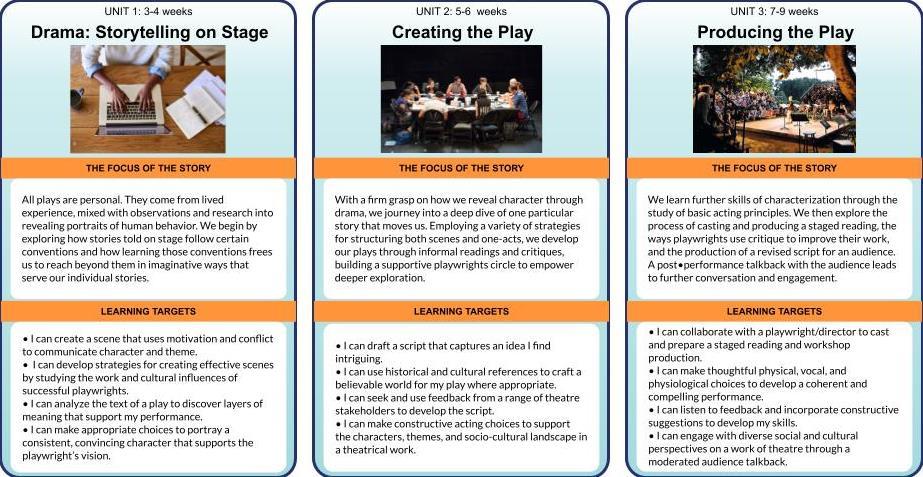
Students will explore the creation and performance of theatre through the writing, rehearsal, and production of a collection of student-written, student-directed, and student-designed one-act plays. They will develop fundamental acting and stage management skills through the exploration of each play’s text. Opportunities may include guest artists and field trips to theatrical productions. This semester course may be taken more than once for credit.
Course Name: One-Act Play Unit Title: Drama: Storytelling on Stage Est. # of Weeks: 3-4
Unit Overview: All plays are personal. They come from lived experience, mixed with observations and research into revealing portraits of human behavior. We begin by exploring how stories told on stage follow certain conventions and how learning those conventions frees us to reach beyond them in imaginative ways that serve our individual stories.
Established Goals Transfer Goals
From CT Arts Standards (Theatre)
● 1c. Use script analysis to generate ideas about a character that is believable and authentic in a drama/theatre work.
● 8b. Identify and compare cultural perspectives and contexts that may influence the evaluation of a drama/theatre work.
● 9c. Formulate a deeper understanding and appreciation of a drama/theatre work by considering its specific purpose or intended audience.
● 10a. Investigate how cultural perspectives, community ideas and personal beliefs impact a drama/theatre work.
● Imaginative work draws from many sources: things we have experienced, things we know others have experienced, and things we long to experience.
● Theater artists explore the use of ideas, performance techniques, and technical aspects to elicit an intended response.
Knowledge
● Develop an idea and explain the inspiration behind the concept
● Actively listen to and interact with others’ ideas, points of view, and feedback to accomplish a goal or task
● Practice and hone technical skills that are essential to their role(s) in the production
Essential Questions
● How do I use what I know, imagine, or long for to inspire a scene?
● What am I learning from sharing my scene with others? How does that impact the creative choices I make?
Skills (Framed as Learning Targets)
● Conventions of one act plays: motivation, conflict, resolution, character, and theme
● Texture: Speech, monologue, soliloquy, dialogue, choral ode, counterpoint
● I can develop strategies for creating effective scenes by studying the work and cultural influences of successful playwrights.
● I can analyze the text of a play to discover layers of meaning that support my performance.
● I can make appropriate choices to portray a consistent, convincing character that supports the playwright’s vision.
Summative Assessment
● Create a scene that reveals character and theme through motivation, conflict, and resolution.
Formative Assessment
● Perform cold readings of classmates’ work in development
● Engage in post-reading feedback sessions with peers and the teacher to improve writing
● Write a series of short scenes based on prompts to develop techniques for “getting started”
● Create a conflict/strategy map for each character in a scene using a graphic organizer
● I can develop strategies for creating effective scenes by studying the work and cultural influences of successful playwrights.
● I can analyze the text of a play to discover layers of meaning that support my performance.
● I can make appropriate choices to portray a consistent, convincing character that supports the playwright’s vision.
● How do I use what I know, imagine, or long for to inspire a scene?
● What am I learning from sharing my scene with others? How does that impact the creative choices I make?
● Introduction to playwriting through a series of short, two-character/ten-speech scenes that scaffold toward deeper conversations about how we communicate character, setting, and theme
● Introduction to acting through improvisation, mask work, and performance of short scenes, designed to support developing understanding of the creation of character
● Introduction to theatre history and playwriting through reading and discussion of short scenes from established playwrights, coupled with an analysis of motivation and context for the creation
Course Name: One-Act Play Unit Title: Creating the Play Est. # of Weeks: 5-6
Unit Overview: With a firm grasp on how we reveal character through drama, we journey into a deep dive of one particular story that moves us. Employing a variety of strategies for structuring both scenes and one-acts, we develop our plays through informal readings and critiques, building a supportive playwrights circle to empower deeper exploration.
Established Goals
CT Arts Standards (Theatre)
● 2a. Explore the function of history and culture in the development of a dramatic concept through a critical analysis of original ideas in a drama/theatre work.
● 4a. Examine how character relationships assist in telling the story of a drama/theatre work.
● 4b. Shape character choices using given circumstances in a drama/theatre work.
● 11.2b. Use basic theatre research methods to better understand the social and cultural background of a drama/theatre work.
Understandings
● Improvising and interpreting a script requires the development of personal voice and original ideas.
● Theater artists evaluate and refine their work through examination of relevant criteria, openness to new ideas, and persistence.
● Character map / biography / lived experience
● Given circumstances such as the weather
● Want, conflicts, stakes, strategies: building blocks of character in a scene or play
● Liz Lerman’s Critical Response Process for providing feedback to creators/playwrights
Transfer Goals
● Develop an idea and explain the inspiration behind the concept
● Actively listen to and interact with others’ ideas, points of view, and feedback to accomplish a goal or task
● Locate and analyze historical and cultural information for a given time period to support artistic choices
● Practice and hone technical skills that are essential to their role(s) in the production
● How do I develop an idea for a one act play? What are the creative choices I am making to bring that idea to life?
● How do I use the historical, cultural, and social world of the play to portray the characters and reveal the themes?
● I can draft a script that captures an idea I find intriguing.
● I can use historical and cultural references to craft a believable world for my play where appropriate.
● I can seek and use feedback from a range of theatre stakeholders to develop the script.
● I can make constructive acting choices to support the characters, themes, and sociocultural landscape in a theatrical work.
Summative Assessment
● Create a researched map of the “world of the play” (historically, culturally, socially)
● Create a one-act play (one scene or multiscene) that reveals character and theme through motivation, conflict, and resolution.
● I can draft a script that captures an idea I find intriguing.
● I can use historical and cultural references to craft a believable world for my play where appropriate.
● I can seek and use feedback from a range of theatre stakeholders to develop the script.
● I can make constructive acting choices to support the characters, themes, and sociocultural landscape in a theatrical work.
Formative Assessment
● Using a graphic organizer, brainstorm ideas for a one-act play and identify the strongest idea for the project.
● Prepare an outline or storyboard of the sequence of dramatic actions
● Share developing drafts regularly for feedback from peers and teacher
● How do I develop an idea for a one act play? What are the creative choices I am making to bring that idea to life?
● How do I use the historical, cultural, and social world of the play to portray the characters and reveal the themes?
● Developing an Idea – brainstorming without editing, reflection on what’s important to the playwright (story, theme, observation of human experience) – the role of improvisation in the writing process – decision making
● Drafting and editing loop – what role do actors play in the development of the script?
● Dramaturgs and directors, producers and friends – other voices in the creative process and how their perspectives can be harnessed for constructive progress
● Casting and preparing for a staged reading – rehearsals, work with producers, the continuing role of actors, directors, and dramaturgs – the “talk-back”
● Reflection and revision – listening to the voices that challenge as much as the voices that support – knowing what’s essential to your story
Course Name: One-Act Play Unit Title: Producing the One Act Play Est. # of Weeks: 7-9
Unit Overview: We learn further skills of characterization through the study of basic acting principles. We then explore the process of casting and producing a staged reading, the ways playwrights use critique to improve their work, and the production of a revised script for an audience. A post-performance talkback with the audience leads to further conversation and engagement.
Established Goals Transfer Goals
From CT Arts Standards (Theatre)
● 2b. Investigate the collaborative nature of the actor, director, playwright, and designers and explore their interdependent roles in a drama/theatre work.
● 3a. Practice and revise a devised or scripted drama/theatre work using theatrical staging conventions.
● 3b. Explore physical, vocal and physiological choices to develop a performance that is believable, authentic, and relevant to a drama/theatre work.
● 8c. Justify personal aesthetics, preferences, and beliefs through participation in and observation of a drama/theatre work.
EFFECTIVE COMMUNICATORS:
● Rehearse and deliver a performance for an audience based on individual role(s) in a production
● Actively listen to and interact with others’ ideas, points of view, and feedback to accomplish a goal or task
● Design and execute with an ensemble or crew to produce a coherent experience for the audience
● Persevere through challenging situations with flexibility and resourcefulness
● Theater artists make thoughtful choices about their use of skills, techniques, and personal experience in hopes of creating a specific response for an audience.
● Theater artists evaluate and refine their work through examination of relevant criteria, openness to new ideas, and persistence.
● Live theatre performance is an inherently unique human experience influenced in real time by the personalities and lived experiences of this particular set of audience members, the physical and cultural climate at this performance, and the choices of actors and crew in response to these conditions.
Knowledge
● What are we paying attention to as we rehearse and refine our plays? How does the feedback we receive improve our performance?
● What am I learning about myself and my ability to handle challenging situations?
● How am I engaging with my audience during the performance and post-show talkback to make meaningful connections?
Skills (Framed as Learning Targets)
● Purpose and nature of a post-show talkback
● Types of production rehearsals and their purposes in the creative process (such as paper tech, dry tech, wet tech, dress rehearsal)
● I can collaborate with a playwright/director to cast and prepare a staged reading and workshop production.
● I can make thoughtful physical, vocal, and physiological choices to develop a coherent and compelling performance.
● I can listen to feedback from other stakeholders and incorporate constructive suggestions to develop my skills.
● I can engage with diverse social and cultural perspectives on a work of theatre through a moderated audience talkback.
Summative Assessment
● Collaborate with a director and creative team to produce a workshop production of a one-act play, both as an actor and as a playwright
● Engage in a question-and-answer session with audience members in a post-show talkback
Formative Assessment
● Participate in technical rehearsals such a cueto-cue and dress rehearsals to support the work of the tech teams
● As an actor, prepare nightly reports of concerns related to costumes and props
● Engage in post-rehearsal feedback sessions with the director for the improvement of the production and preparation for the talkback
Learning Targets Essential Questions
● I can collaborate with a playwright/director to cast and prepare a staged reading and workshop production.
● I can make thoughtful physical, vocal, and physiological choices to develop a coherent and compelling performance.
● I can listen to feedback from other stakeholders and incorporate constructive suggestions to develop my skills.
● I can engage with diverse social and cultural perspectives on a work of theatre through a moderated audience talkback.
● What are we paying attention to as we rehearse and refine our plays? How does the feedback we receive improve our performance?
● What am I learning about myself and my ability to handle challenging situations?
● How am I engaging with my audience during the performance and post-show talkback to make meaningful connections?
● Preparing casting notes and conferring with the director or playwright throughout the casting process; understanding the director’s role as well as the playwright’s role
● Coaching actors to reveal subtext and to connect with other characters by using various theatre games such as Gibberish (for subtext work) and Who’s The Mirror? (for connection work)
● Effective physical and vocal warm ups for performance; building ensemble and encouraging affirmation; overcoming stressors like stage fright
● Collaborating with technical teams to ensure everyone is on the same page during the performance
● Active listening exercises to keep your character engaged in the moment even when not speaking
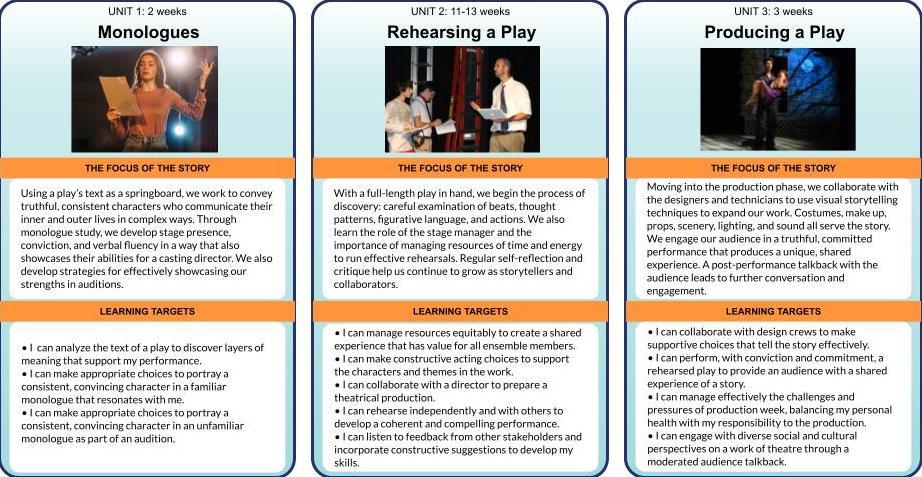
Theatre Ensemble
Students will explore the history and performance of theatre through the rehearsal and production of a full-length play. They will develop advanced acting and stage management skills through the exploration of the play’s text, audition monologues, and related scenes. Material studied may include mature content. Opportunities may include guest artists and field trips to theatrical productions. This semester course may be taken more than once for credit.
Course Name: Theatre Ensemble Unit Title: Monologues Est. # of Weeks: 2
Unit Overview: Using a play’s text as a springboard, we work to convey truthful, consistent characters who communicate their inner and outer lives in complex ways. Through monologue study, we develop stage presence, conviction, and verbal fluency in a way that also showcases their abilities for a casting director. We also develop strategies for effectively showcasing our strengths in auditions.
Established Goals
From CT Arts Standards (Theatre)
● 1c. Use script analysis to generate ideas about a character that is believable and authentic in a drama/theatre work.
● 4b. Shape character choices using given circumstances in a drama/theatre work.
● 5a. Practice various acting techniques to expand skills in a rehearsal or drama/theatre performance.
● Successful theatre auditions involve a combination of intense preparation and “in the moment” adaptability.
Knowledge
● Script analysis: character motivation, given circumstances, conflict, resolution, subtext
● Character map / biography / lived experience
Transfer Goals
EFFECTIVE COMMUNICATORS:
● Rehearse and deliver a performance for an audience based on individual role(s) in a production
● Actively listen to and interact with others’ ideas, points of view, and feedback to accomplish a goal or task
● Practice and hone technical skills that are essential to their role(s) in the production
Essential Questions
● How do I prepare for an audition to make a good impression?
Skills (Framed as Learning Targets)
● I can analyze the text of a play to discover layers of meaning that support my performance.
● I can make appropriate choices to portray a consistent, convincing character in a familiar monologue that resonates with me.
● I can make appropriate choices to portray a consistent, convincing character in an unfamiliar monologue as part of an audition.
Summative Assessment
● Select, develop, and perform a monologue in an audition setting
● Perform an unfamiliar monologue (“cold” reading) in an audition setting
Formative Assessment
● Regular feedback on monologue performance to prepare for audition
● Generate ideas for a monologue using a graphic organizer
● 1:1 feedback sessions to ensure personalized assistance for monologue development
● I can analyze the text of a play to discover layers of meaning that support my performance.
● I can make appropriate choices to portray a consistent, convincing character in a familiar monologue that resonates with me.
● I can make appropriate choices to portray a consistent, convincing character in an unfamiliar monologue as part of an audition.
● How do I prepare for an audition to make a good impression?
● Effective warm up strategies to get yourself mentally and physically prepared to do your best
● Practice cold readings and ways of implementing character details as you encounter them
● Exploring audition etiquette in interactions with the director as well as with auditionees
● Using formal and informal rubrics to evaluate whether a monologue works for you and for your audition
Course Name: Theatre Ensemble Unit Title: Rehearsing a Play Est. # of Weeks: 11-13
Unit Overview: With a full-length play in hand, we begin the process of discovery: careful examination of beats, thought patterns, figurative language, and actions. We also learn the role of the stage manager and the importance of managing resources of time and energy to run effective rehearsals. Regular selfreflection and critique help us continue to grow as storytellers and collaborators.
Established Goals
From CT Arts Standards (Theatre)
● 2a. Explore the function of history and culture in the development of a dramatic concept through a critical analysis of original ideas in a drama/theatre work.
● 3a. Practice and revise a devised or scripted drama/theatre work using theatrical staging conventions.
● 4a. Examine how character relationships assist in telling the story of a drama/theatre work.
● 4b. Shape character choices using given circumstances in a drama/theatre work.
● 11.2b. Use basic theatre research methods to better understand the social and cultural background of a drama/theatre work.
Understandings
● Theatre artists evaluate and refine their work through examination of relevant criteria, openness to new ideas, and persistence.
● Theatre is an expressive art form that can both connect people across various time periods and reflect historical divides/stereotypes.
● Live theatre performance is an inherently unique human experience influenced in real time by the personalities and lived experiences of this particular set of audience members, the physical and cultural climate at this performance, and the choices of actors and crew in response to these conditions.
Transfer Goals
EFFECTIVE COMMUNICATORS:
● Actively listen to and interact with others’ ideas, points of view, and feedback to accomplish a goal or task
INFORMATION ANALYSTS, CRITICAL THINKERS:
● Locate and analyze historical and cultural information for a given time period to support artistic choices
● Practice and hone technical skills that are essential to their role(s) in the production
Essential Questions
● How does the feedback I receive improve my performance?
● How does the history of a performance piece influence my interpretation?
● What am I learning about myself and my ability to handle challenging situations?
Knowledge
● A theatre production carries the weight and influence of three different time periods, each with its own social and cultural contexts:
- When the play takes place;
- When the play was written, and - When the play is being performed.
● Shorthand for recording staging (for both actors and stage managers) including stage position, body position, level, and movement
Skills (Framed as Learning Targets)
● I can manage resources equitably to create a shared experience that has value for all ensemble members.
● I can make constructive acting choices to support the characters and themes in the work.
● I can collaborate with a director to prepare a theatrical production.
● I can rehearse independently and with others to develop a coherent and compelling performance.
● I can listen to feedback from other stakeholders and incorporate constructive suggestions to develop my skills.
Summative Assessment
● Justification of acting choices with analysis of a character’s actions (motivation, conflict, given circumstances). These can be written and/or oral explanations.
● Perform an appropriate scene from the play from memory, incorporating direction and feedback.
Formative Assessment
● Create a chart of the beats of a scene or monologue using a graphic organizer
● Collaborate with a student group as they rehearse by serving the role of prompter/stage manager
● Draft a prop plot for their character
Learning Targets Essential Questions
● I can manage resources equitably to create a shared experience that has value for all ensemble members.
● I can make constructive acting choices to support the characters and themes in the work.
● I can collaborate with a director to prepare a theatrical production.
● I can rehearse independently and with others to develop a coherent and compelling performance.
● I can listen to feedback from other stakeholders and incorporate constructive suggestions to develop my skills.
● How does the feedback I receive improve my performance?
● How does the history of a performance piece influence my interpretation?
● What am I learning about myself and my ability to handle challenging situations?
● Researching the “world of the play” through various media including newspapers, magazines, visual art (painting, sculpture, textiles), fashion, and music; crafting a context for a character’s motivations and conflicts
● Using beat analysis to explore shifts in the subtext throughout a scene; formatting the dialogue in a scene to diagram this shifts visually
● Journaling to reflect on connections between your personal life and that of the character’s
● Engaging in conversation with a director about character choices and motivations behind those choices; openly exploring other approaches when asked and reflecting on how “wrong” choices can help guide us to better ones
● Sharing space and resources through a series of observational “energy” games such as Veruga, Who Started the Motion?, and Three Changes to develop spatial awareness and group dynamics
● Active listening exercises to keep your character engaged in the moment even when not speaking
Course Name: Theatre Ensemble Unit Title: Producing a Play Est. # of Weeks: 3-4
Unit Overview:
Moving into the production phase, we collaborate with the designers and technicians to use visual storytelling techniques to expand our work. Costumes, make up, props, scenery, lighting, and sound all serve the story. We engage our audience in a truthful, committed performance that produces a unique, shared experience. A post-performance talkback with the audience leads to further conversation and engagement.
Established Goals
From CT Arts Standards (Theatre)
● 2b. Investigate the collaborative nature of the actor, director, playwright, and designers and explore their interdependent roles in a drama/theatre work.
● 3b. Explore physical, vocal and physiological choices to develop a performance that is believable, authentic, and relevant to a drama/theatre work.
● 6a. Perform a scripted drama/theatre work for a specific audience.
● 8c. Justify personal aesthetics, preferences, and beliefs through participation in and observation of a drama/theatre work.
● 10a. Investigate how cultural perspectives, community ideas and personal beliefs impact a drama/theatre work.
Understandings
● Actors make thoughtful choices about their use of skills, techniques, and personal experience in hopes of creating a specific response for an audience.
● Actors evaluate and refine their work through examination of relevant criteria, openness to new ideas, and persistence.
● Every audience member encounters the show through the lens of their lived experiences, who is around them, and their physical location in the theatre space.
Knowledge
Transfer Goals
● Rehearse and deliver a performance for an audience based on individual role(s) in a production
● Design and execute with an ensemble or crew to produce a coherent experience for the audience
● Persevere through challenging situations with flexibility and resourcefulness
Essential Questions
● What are we paying attention to as we rehearse and refine our plays? How does the feedback we receive improve our performance?
● What am I learning about myself and my ability to handle challenging situations?
● How am I engaging with my audience during the performance and post-show talkback to make meaningful connections?
Skills (Framed as Learning Targets)
● Purpose and nature of a post-show talkback
● Awareness of multiple perspectives both historically and with contemporary audiences
● Types of production rehearsals and their purposes in the creative process (such as paper tech, dry tech, wet tech, dress rehearsal)
● I can collaborate with design crews to make mutually supportive choices that tell the story effectively.
● I can perform, with conviction and commitment, a rehearsed play to provide an audience with a shared experience of a story.
● I can manage effectively the challenges and pressures of production week, balancing my personal health with my responsibility to the production.
● I can engage with diverse social and cultural perspectives on a work of theatre through a moderated audience talkback.
Summative Assessment Formative Assessment
● Perform a role in a play as part of an ensemble
● Engage in a question-and-answer session with audience members in a post-show talkback
● Participate in technical rehearsals such a cueto-cue and dress rehearsals to support the work of the tech teams
● Prepare nightly reports of concerns related to costumes and props
● Engage in post-rehearsal feedback sessions with the director for the improvement of the production and preparation for the talkback
Learning Targets Essential Questions
● I can collaborate with design crews to make mutually supportive choices that tell the story effectively.
● I can perform, with conviction and commitment, a rehearsed play to provide an audience with a shared experience of a story.
● I can manage effectively the challenges and pressures of production week, balancing my personal health with my responsibility to the production.
● I can engage with diverse social and cultural perspectives on a work of theatre through a moderated audience talkback.
● What are we paying attention to as we rehearse and refine our plays? How does the feedback we receive improve our performance?
● What am I learning about myself and my ability to handle challenging situations?
● How am I engaging with my audience during the performance and post-show talkback to make meaningful connections?
● Using schedules and priority lists to help manage the challenges of production week and achieve both individual and collective goals
● Effective physical and vocal warm ups for performance; building ensemble and encouraging affirmation; overcoming stressors like stage fright
● Collaborating with technical teams to ensure everyone is on the same page during the performance
● Actively and appropriately engaging in notes sessions, whether before or after rehearsal, in person or through written notes; reflecting constructively on how to improve the performance and move the production forward
● Journaling to reflect on what you’re learning about theatre and about yourself; using those reflections to set achievable goals with given resources
● Practicing audience talk-backs through informal interviews in both small and large group settings, with peers as well as with the director